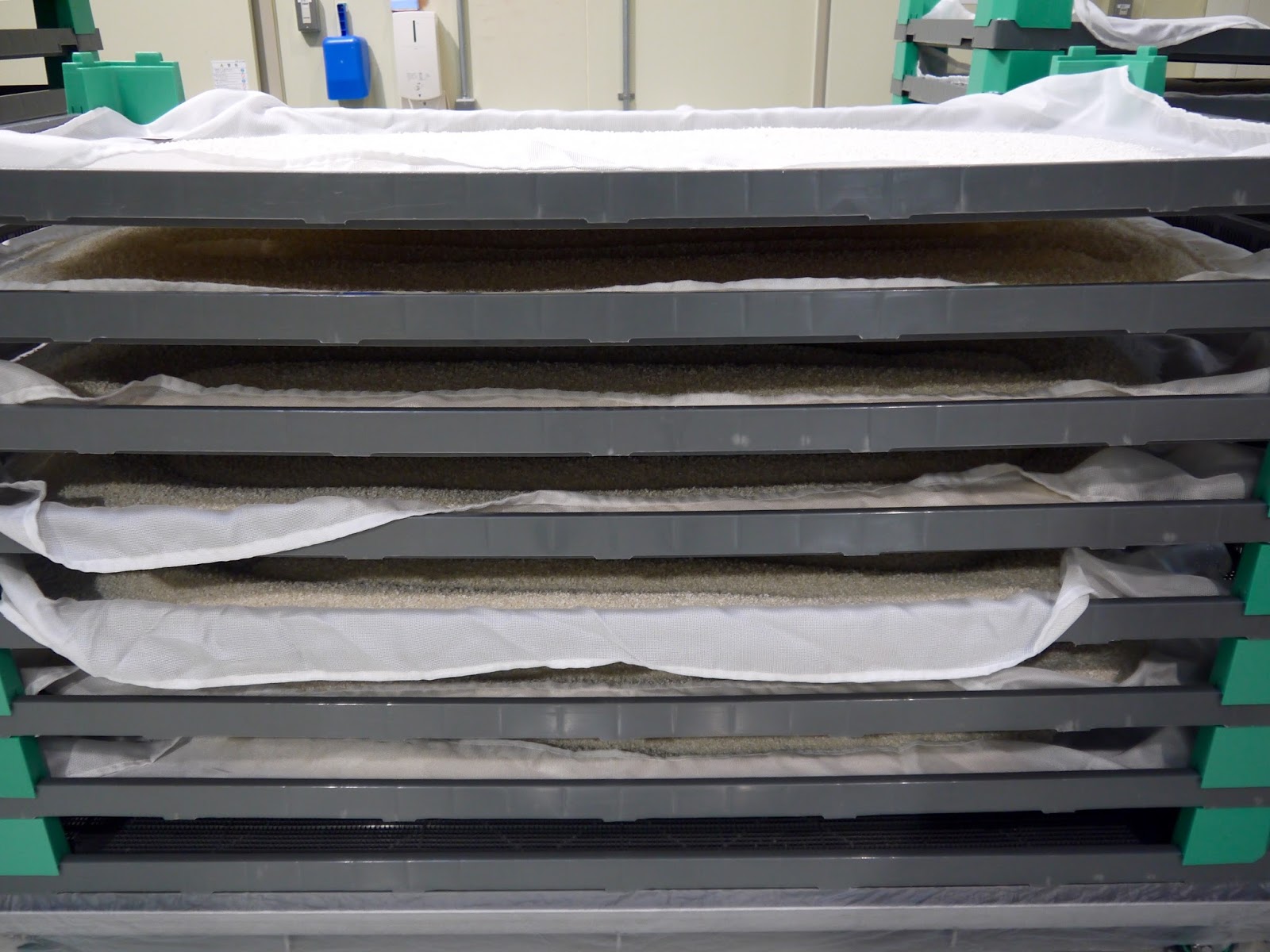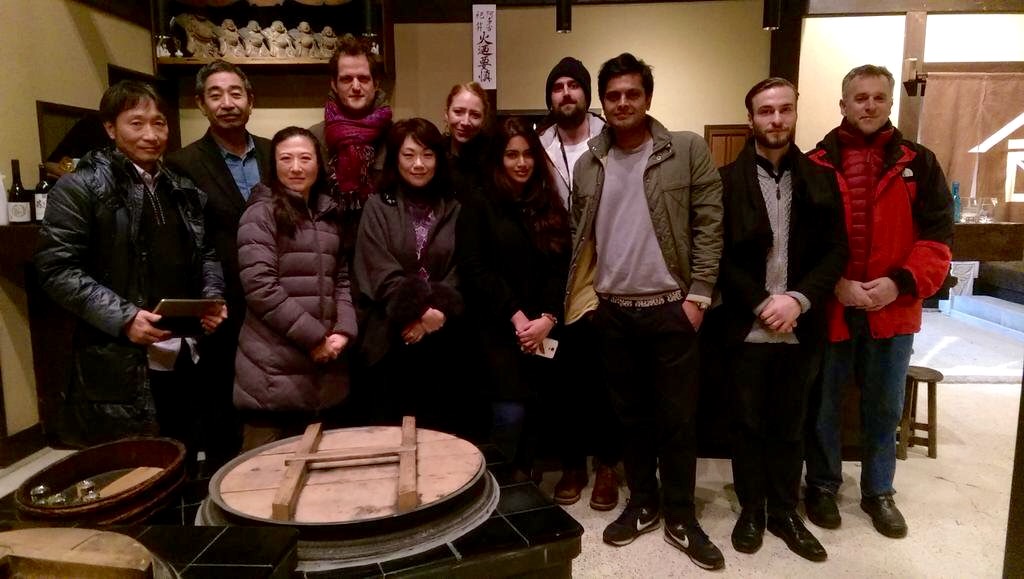Until last month I'd never been to Asia. I've travelled around a lot of Europe and a few places beyond but had never made it that far East. Then an email landed in my inbox at the beginning of January inviting me on a sake tour of Japan three weeks later, so off I went.
Japan was fascinating - I learnt so much, laughed so hard, ate some of the best food I've tried, saw sights that blew my mind and sampled more sake than I ever thought possible. I've got so much to write about our trip, so will break it down by city over the next couple of weeks on here (we did five cities in eight days!) but today's post is all about the sake.
Sake is the national drink of Japan and has been an integral part of Japanese culture for well over 1,500 years, and according to one video we watched, "makes interactions with others smoother". Sake is a Japanese rice wine made by fermenting rice which has been polished to get rid of the outer bran. Most white rice that we eat has been polished 10% - getting rid of the bran, and leaving 90% of the grain. Rice used in sake making can be polished up to 65%, leaving only 35% of the grain remaining. The rice is polished in a rotating machine with a sharp stone which makes it purer, clearer and more expensive.
After the rice polishing, sake making begins with a process called Koshiki, which is the steaming of the rice after it has been washed and soaked.
The rice is steamed to an exact time and its condition is then checked by squeezing a handful of the rice into a putty like form called honori mochi to work out if it's been steamed correctly. This is done by the Toji, who is the master brewer. The steamed rice, known as Koji, is then spread out so it cools down quickly. The Koji is moved into a room called a Koji Muro where the temperature and humidity is kept high, and where mould spores are sprinkled onto the rice.
After two days the temperature is lowered and the rice thoroughly mixed. On day three the rice is removed from the Koji Muro. The koji is then added to tanks with water, more steamed rice and yeast. After being left for a day, more water, steamed rice and koji is added. This mixture then ferments for 2-4 weeks, bubbling away as the starch converts to glucose which creates alcohol.
Once the fermentation time is up the mixture is squeezed to extract the sake.
The sake is filtered, pasteurised and matured, for anywhere between 8 months and seven years to create a well rounded and aromatic drink.
A ball of fresh cedar leaves is hung in front of the brewery to announce a new batch of sake.
The quality of a sake varies depending on the water used to make it, the strain and polish of the rice used to make it, the yeast and mould used, and the temperatures and timings of the brewing, much like the factors that attribute to the quality of a wine.
The first of the three breweries we visited on our tour was also the smallest. The Tsukino Katsura brewery is in the south of Kyoto city in the Fushimi area and is a micro brewery. It's also the oldest brewery in Fushimi, where there are a total of 24 breweries thanks to the good water in the area. The Tsukino brewery produces 180,000 litres of sake each year, all of which is made manually using the brewery's own rice that they cultivated over 22 years ago. They are the only brewery to produce a sparkling sake made with 35% polished rice, which is one of their 12 types of sake.
Brewery number 2 was in Kobe and the complete opposite of the Tsukino brewery. The Hakutsuru brewery is one of the largest in Japan and produces sake both mechanically and manually. Founded in 1743 the Hakutsuru breweries has several sites, a museum, a beauty salon, and even a high school. They make and export over 50 million litres of 45-50 different types of sake to over 40 countries (most of which are made manually - the machines pump out huge volumes but only of 5 or 6 of the nearly 50 types).
The last of the breweries we visited was right up in the mountains, which we travelled to from Nagoya (on a treacherous feeling, winding three hour minibus journey). The Sekiya brewery was worth the trip though. As with all the breweries we visited, they have their own rice and rice fields, and due to being in colder climes than the other two breweries they have a longer sake production period in the year. They make 1,800,000 litres of 15 different types of sake and also make their own plum wine on the same site. Sekiya Brewery's owner took us to his excellent restaurant in Nagoya after our trip to his brewery but I'll cover that in a separate post.
If you're looking to try some sake in London there are a couple of great events going on this month. Japanese restaurant Chisou are doing a sake and Italian cheese pairing evening on 8th March at their Knightsbridge branch, and The Hoxton Shoreditch are showcasing 20 different types of sake this week, until 6th March. The Newly opened Gyoza Bar also do a food and sake offering, and I'll be doing a pop up later this year pairing British seasonal food with sakes throughout the menu.
Japan was fascinating - I learnt so much, laughed so hard, ate some of the best food I've tried, saw sights that blew my mind and sampled more sake than I ever thought possible. I've got so much to write about our trip, so will break it down by city over the next couple of weeks on here (we did five cities in eight days!) but today's post is all about the sake.
Sake is the national drink of Japan and has been an integral part of Japanese culture for well over 1,500 years, and according to one video we watched, "makes interactions with others smoother". Sake is a Japanese rice wine made by fermenting rice which has been polished to get rid of the outer bran. Most white rice that we eat has been polished 10% - getting rid of the bran, and leaving 90% of the grain. Rice used in sake making can be polished up to 65%, leaving only 35% of the grain remaining. The rice is polished in a rotating machine with a sharp stone which makes it purer, clearer and more expensive.
After the rice polishing, sake making begins with a process called Koshiki, which is the steaming of the rice after it has been washed and soaked.
The rice is steamed to an exact time and its condition is then checked by squeezing a handful of the rice into a putty like form called honori mochi to work out if it's been steamed correctly. This is done by the Toji, who is the master brewer. The steamed rice, known as Koji, is then spread out so it cools down quickly. The Koji is moved into a room called a Koji Muro where the temperature and humidity is kept high, and where mould spores are sprinkled onto the rice.
After two days the temperature is lowered and the rice thoroughly mixed. On day three the rice is removed from the Koji Muro. The koji is then added to tanks with water, more steamed rice and yeast. After being left for a day, more water, steamed rice and koji is added. This mixture then ferments for 2-4 weeks, bubbling away as the starch converts to glucose which creates alcohol.
Once the fermentation time is up the mixture is squeezed to extract the sake.
The sake is filtered, pasteurised and matured, for anywhere between 8 months and seven years to create a well rounded and aromatic drink.
A ball of fresh cedar leaves is hung in front of the brewery to announce a new batch of sake.
The quality of a sake varies depending on the water used to make it, the strain and polish of the rice used to make it, the yeast and mould used, and the temperatures and timings of the brewing, much like the factors that attribute to the quality of a wine.
The first of the three breweries we visited on our tour was also the smallest. The Tsukino Katsura brewery is in the south of Kyoto city in the Fushimi area and is a micro brewery. It's also the oldest brewery in Fushimi, where there are a total of 24 breweries thanks to the good water in the area. The Tsukino brewery produces 180,000 litres of sake each year, all of which is made manually using the brewery's own rice that they cultivated over 22 years ago. They are the only brewery to produce a sparkling sake made with 35% polished rice, which is one of their 12 types of sake.
Brewery number 2 was in Kobe and the complete opposite of the Tsukino brewery. The Hakutsuru brewery is one of the largest in Japan and produces sake both mechanically and manually. Founded in 1743 the Hakutsuru breweries has several sites, a museum, a beauty salon, and even a high school. They make and export over 50 million litres of 45-50 different types of sake to over 40 countries (most of which are made manually - the machines pump out huge volumes but only of 5 or 6 of the nearly 50 types).
The last of the breweries we visited was right up in the mountains, which we travelled to from Nagoya (on a treacherous feeling, winding three hour minibus journey). The Sekiya brewery was worth the trip though. As with all the breweries we visited, they have their own rice and rice fields, and due to being in colder climes than the other two breweries they have a longer sake production period in the year. They make 1,800,000 litres of 15 different types of sake and also make their own plum wine on the same site. Sekiya Brewery's owner took us to his excellent restaurant in Nagoya after our trip to his brewery but I'll cover that in a separate post.
If you're looking to try some sake in London there are a couple of great events going on this month. Japanese restaurant Chisou are doing a sake and Italian cheese pairing evening on 8th March at their Knightsbridge branch, and The Hoxton Shoreditch are showcasing 20 different types of sake this week, until 6th March. The Newly opened Gyoza Bar also do a food and sake offering, and I'll be doing a pop up later this year pairing British seasonal food with sakes throughout the menu.























Amazing! A - I'm desperate to go to Japan, it's been on my list forever, and B - I love any sort of 'how do you make XYZ tours!
ReplyDeleteIt was SO good - really interesting and Japan is wonderful! Lots more Japan posts coming soon...
DeleteRosie xx
How amazing!!! I'm really hoping to get to Japan this year.
ReplyDeleteI have so many recommendations Angie! It was amazing :)
DeleteRosie xx
I loooooove Japanese culture and I'm super jealous you get to go on a sake tour! Chisou does have an awesome selection of sake. :)
ReplyDeleteHoney x The Girl Next Shore
It was SO GOOD! I can't wait to go back to Japan now :)
DeleteRosie xx